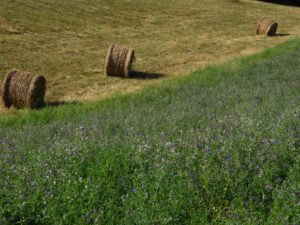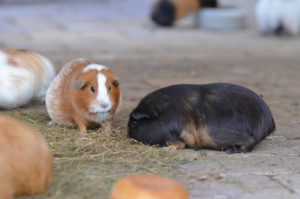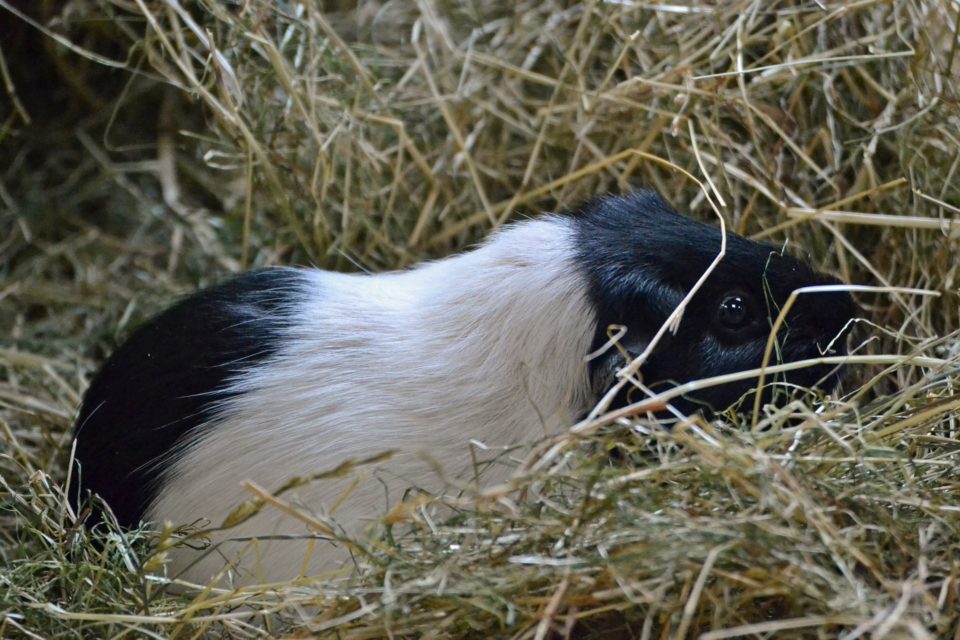Hello! My name is Casey and I have both professional and personal experience in the care and ownership of all sorts of pocket pets!
I was a veterinary technician for 7 years and have treated, owned, and fostered various pigs over the years.
Guinea pigs have always been a favorite from the realm of pocket pets, each of them has their own big personalities and it’s a joy to have them in my life!
Guinea pigs make fantastic pets for both children and adults alike and are relatively low maintenance.
Hearing about my love for guinea pigs isn’t why you’re here though! You’re here to learn more about what the best hay is for your pigs to eat!
Not only is it prudent to find the best hay type, but knowing the most trusted and consistent brands is key as well. I know I’ve always hated inconsistencies in quality, and so have my pigs!
So you may now be asking yourself this next big question.
Why is Hay so Important For Guinea Pigs?
Hay has a number of benefits for our guinea pigs health, which is why it is always recommended to keep a fresh supply of hay available for nibbling on 24/7 for these little furballs.
The core reasons for this are as follows:
1. Hay provides a natural chew source to keep teeth ground down.
 Like most rodent type pets, guinea pigs have what is called open-rooted teeth, which basically means they never stop growing.
Like most rodent type pets, guinea pigs have what is called open-rooted teeth, which basically means they never stop growing.
Without the natural gnawing, guinea pig teeth would continuously grow, meaning they would need to be manually trimmed by your veterinarian.
Even so, if your pig’s bite is off and they can’t gnaw properly to keep their teeth ground down, they may need manual trimmings throughout their lifetime.
2. Hay provides the necessary fiber to keep things moving!
A good hay keeps a pig’s digestive tract functioning properly by keeping natural bacteria balanced while stimulating normal movements in the gut.
Without enough roughage, guinea pigs are susceptible to life-threatening gastrointestinal illnesses such as diarrhoea. So those little pellet poops mean your pig is good to go!
3. Hay encourages natural behaviors of grazing.
Sometimes, a pocket pets favorite past time is eating. Pure and simple, this activity can keep them engaged for hours at a time.
It’s a perfectly natural behavior and the more natural they are, the more comfortable and relaxed they feel, this reduction in stress goes a long way to keeping your pigs happy and healthy.
What Are The Different Types of Hay?
When it comes to the types of hay, there are more options out there than you may realize, including grass hays, legume hays and grain hays.
Since not all hay is made equal, I’m going to take some time to review the more commonplace hay options along with how they either benefit or harm your pig’s overall health.
Timothy Hay
 Timothy hay is the top go-to grass hay for most pig owners and with good reason! It is easy to find both online and in local pet shops, is high in fiber and low in protein and calcium.
Timothy hay is the top go-to grass hay for most pig owners and with good reason! It is easy to find both online and in local pet shops, is high in fiber and low in protein and calcium.
Timothy hay contains coarse stems that provide great nibbling material for keeping teeth ground down while remaining nutrient rich enough to give your pigs what they need.
The biggest thing to keep in mind with Timothy hay is the fact that the seed heads are not only a typical favorite among guinea pigs, but are also the portion of the hay that is the lowest in both nutritional value and fiber.
I’ve had fantastic luck with Timothy hay for most all of my pocket pets.
Orchard Grass Hay
Orchard grass hay is similar to Timothy hay in terms of nutrition and fiber content.
It is, however, less coarse and much softer which makes this variety a poor choice if you’re wanting to help your guinea pigs keep their teeth ground down.
Despite this, orchard grass hay makes a great addition to their diet and many pig parents mix orchard grass hay into their staple hay as an additional sweet treat.
Oat Hay
Unlike the previous two grass hays, Oat hay is actually a grain-based hay, meaning it’s higher in natural fats and sweetness.
Unfortunately if fed as a staple hay, your pigs have a higher chance of becoming overweight. For this reason, I’d recommend oat hay being used as an option to treat your pigs.
Using different hay types for treats while keeping one staple hay for 24/7 will give your pigs something to get excited about! I would caution doing too many ‘treat hays’ in a single day as your pigs may then begin to expect the different hays.
A routine of once per day with a treat hay is great, especially when you get your little pigs on a schedule, you’ll see their excitment as the time for their treat hay comes closer.
Alfalfa Hay
 Alfalfa is a legume type hay that is high in fiber, protein, and calcium. This is a poor choice for adult guinea pigs but fantastic for young, pregnant and nursing pigs.
Alfalfa is a legume type hay that is high in fiber, protein, and calcium. This is a poor choice for adult guinea pigs but fantastic for young, pregnant and nursing pigs.
Please note that alfalfa hay should never be used as a staple simply due to the high calcium content.
The reason for this is calcium has the high potential to cause bladder stones in average adult pigs, which is never fun to have or treat as it can be quite painful and cause bloody urine.
Hay Cuts
Before I go further and begin my review of the various brand options, I want to review the cuts or harvest times for hay.
There are three different harvest cycles that can give you more insight into exactly what you’re feeding your guinea pigs and help you determine what they need!
The first cut is basically when the hay is grown and then harvested when it’s ready. This is actually the most common type of hay you’ll find in the major pet stores as it’s the one farmers typically do to maintain revenue. This cut usually has more seed heads (the big floofy parts at the top,) and the stems are more coarse which is good for grinding down your pig’s teeth.
The second cut is when the hay has been harvested once and then allowed to regrow from the same roots. This cut is not only softer and leafier but has fewer seed heads. This allows the guinea pigs to focus on the stems, which are higher in fiber and nutrients than the seed heads.
The final cut is the third, which is, you guessed it, the third time the hay will have been harvested from the same roots. This particular cut serves more as a treat than a viable staple for the 24/7 hay requirement as it is extra soft, leafy, very low in fiber and high in protein. None of which makes a good mix for pigs. As stated above, it is, however, a great treat to occasionally serve!
Now that you’re armed with the knowledge of the various cuts, it’s time to look at which brands are the highest recommended for your guinea pig hay!
Best Hay for Guinea Pig’s
1. Standlee Premium Western Forage Timothy Grass
While this product is listed as grass, the fact that they have taken the time to dry it makes it actually hay!
This high quality Western Forage grass hay is grown in the state of Southern Idaho in an area of nutrient-rich volcanic soils where there is abundant sun, and low humidity, making this the ideal environment for the growth of nutritious grass hay.
This premium Western Forage has avoided the use of additives and preservatives so you know each bag contains hay that is fresh from the field and ready for your little pigs to enjoy!
The drying process for the timothy grass is the all natural method of being sun-cured, which ensures a delicious crunch that will excite your pigs! The long stems encourage natural foraging behaviors and will help keep your guinea pigs teeth perfectly ground down.
This Western Forage hay is high in fiber and low in protein and calcium. This hay will help keep the gastrointestinal tract of your pigs functioning properly making it ideal for a 24/7 staple feed for your pigs!
The packaged product is consistently a first cut harvest, providing optional teeth grinding firmness with a healthy amount of seed heads that provide an excellent treat for your guinea pigs.
2. Oxbow Animal Health Orchard Grass Hay for Pets
Perhaps one of the most commonplace pocket pet food brands in major pet stores is Oxbow. They have a lovely variety of foods available for all types of pocket pets including this sweet-smelling orchard grass hay.
Orchard grass hay is high in fiber, and low in protein, aiding in weight management to prevent obesity in our little pigs. Unlike Timothy grass hay, Orchard grass hay has a softer texture and less crunch with more leafs for our pigs to munch on.
Because of these differences, there is no denying that my pigs have always adored their share of Orchard grass hay! I typically mix it in with my Timothy grass hay to provide a delicious mix that keeps my pigs busy foraging.
This Orchard grass hay is packed into durable plastic bags that keep the hay fresh and fit for travel, all while sealing in the sweet fragrance of this nutritional hay. If you find yourself with a picky eater, offer them a bit of Orchard grass hay to see if you can entice them to give it a try.
You can start with mixing a higher percentage of Orchard hay with Timothy and slowly transition over to a majority of Timothy hay over a few days time. I have found this method to work wonders for my picky eaters, but it may not work for all pigs! As they do each have their own big personalities!
My personal experience with the Oxbow bran of Orchard grass hay has always been positive! This hay is basically dust-free, green and fresh, making it a great option to mix in with my preferred timothy hay!
3. Oxbow Animal Health Oat Hay For Pets
A second fantastic option from Oxbow is this hearty and nutritious oat hay. As stated above, this isn’t a grass hay but a grain hay. Making it a great treat hay for your guinea pigs.
This particular oat hay was harvested at the ideal time for guinea pig consumption, farmers keep a close watch on this oat hay as it grows and harvests before the oats develop into seeds.
This ensures a delicious pig friendly crunchy husk for them to enjoy and gnaw on, providing you the comfort in knowing your pigs teeth are properly ground down and lowering the risk of overgrown teeth and other dental concerns.
Guinea pigs adore oat hays due to the difference in fragrance, texture and flavors from the more common grass hays. The healthy fats within this grain hay helps promote a healthy shine to your pigs coat, while the high fiber promotes a healthy digestive tract.
I’ve always had a great experience with Oxbow and this oat hay is no different! Both my personal experience and fellow reviews boast of the freshness of this hay and the fact that stubborn pocket pets who typically turn up their nose at other hay options, approve!
4. Oxbow Animal Health Alfalfa Hay for Pets
The final hay for review on my list is a pocket pet favorite Alfalfa hay. The “Junk food” of the hay world for pocket pets, Alfalfa hay is only really a fantastic option for young pigs under 4 months of age, then pregnant, lactating or malnourished adults.
Only under these specific circumstances is the Oxbow Alfalfa hay a great addition to your usual staple hay. This fact is so important that even the packaging shows a clear statement that this hay is great in specific cases, including being only used as a good treat for healthy adult pigs.
Alfalfa hay is sweet, fresh palatable and packed full of nutritional benefits. It contains all the needed fiber, enegry, protein, calories and calcium fit for those pigs in need.
It really is the wonder food of the hay world which makes it a fantastic complement for those guinea pigs who need an extra boost in their diet!
The stalks are firm enough to provide proper teeth grinding, while retaining their leafy goodness that makes this a favorite nibbling hay among the pocket pet world.
I have always found the Oxbow Alfalfa hay to be fresh and dust free with a fragrance that makes it almost good enough to throw in my salad!
Final Thoughts: What is The Best Hay for Guinea Pigs?
Providing hay 24/7 is crucial for your guinea pigs mental and physical health, as is finding the right combination of staple hay, treat hay and hay that you just feel like mixing in.
Knowing your pigs health needs will go a long way in ensuring they remain healthy and happy pigs!
Not only is hay great for keeping your little pigs busy, but it’s also great for their digestion too!
Knowing what to look for in the hay you provide will help you in ensuring your pigs are getting everything they need, and not overdoing it on the hays that are too high in proteins and calcium.

While there are still more hay types than I’ve listed here, I’ve chosen to cover the most common, easily available and popular hay options.
Now that you’re armed with hay knowledge you can explore different varieties to find your pigs favorites!
If you have any comments or questions, please leave them below!




